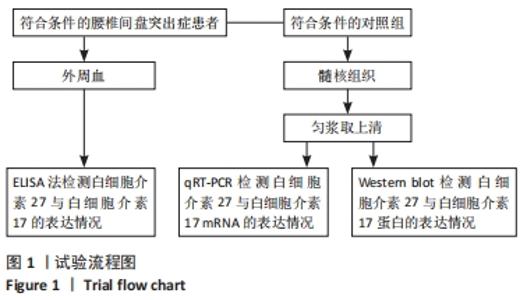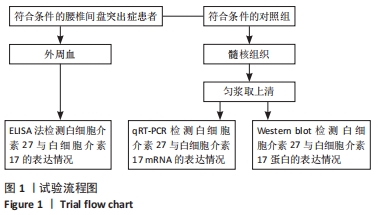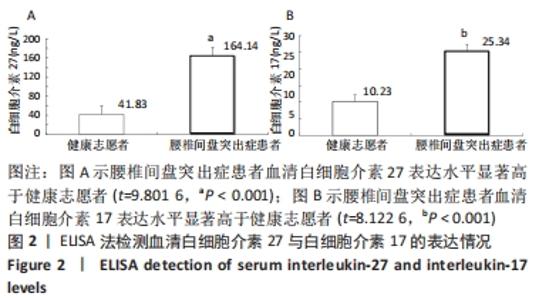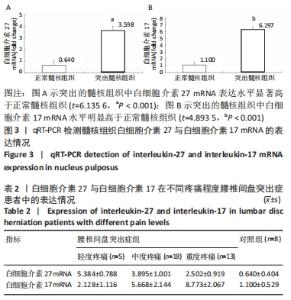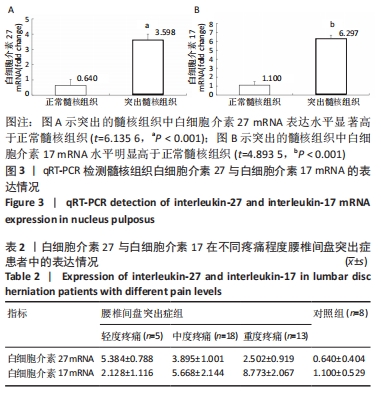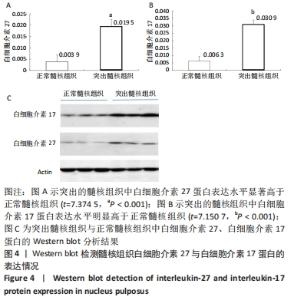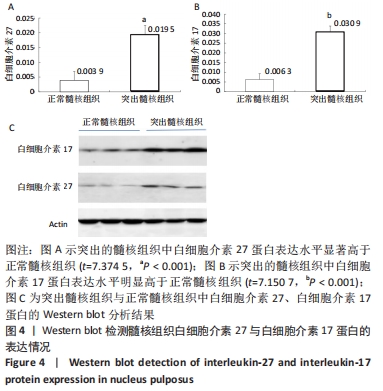Chinese Journal of Tissue Engineering Research ›› 2022, Vol. 26 ›› Issue (23): 3750-3755.doi: 10.12307/2022.678
Previous Articles Next Articles
Interleukin-27 is associated with the pathogenesis of lumbar disc herniation
Xue Huawei1, 2, Zhu Min1, 2, Li Yuqian1, 2
- 1Department of Orthopedics, the Third People’s Hospital of Nantong, Nantong 226000, Jiangsu Province, China; 2Nantong University School of Medicine, Nantong 226000, Jiangsu Province, China
-
Received:2021-05-06Accepted:2021-06-24Online:2022-08-18Published:2022-02-12 -
Contact:Li Yuqian, Master, Chief physician, Associate professor, Department of Orthopedics, the Third People’s Hospital of Nantong, Nantong University, Nantong 226000, Jiangsu Province, China -
About author:Xue Huawei, Master, Associate chief physician, Department of Orthopedics, the Third People’s Hospital of Nantong, Nantong University, Nantong 226000, Jiangsu Provence, China -
Supported by:the Research project of Nantong Health and Family Planning Commission, No. WKZL2018065 (to XHW)
CLC Number:
Cite this article
Xue Huawei, Zhu Min, Li Yuqian. Interleukin-27 is associated with the pathogenesis of lumbar disc herniation[J]. Chinese Journal of Tissue Engineering Research, 2022, 26(23): 3750-3755.
share this article
Add to citation manager EndNote|Reference Manager|ProCite|BibTeX|RefWorks
| [1] GILBERTSON L, AHN SH, TENG PN, et al. The effects of recombinant human bone morphogenetic protein-2, recombinant human bone morphogenetic protein-12, and adenoviral bone morphogenetic protein-12 on matrix synthesis in human annulus fibrosis and nucleus pulposus cells. Spine J. 2008;8(3):449-456. [2] SCHWARZER AC, APRILL CN, DERBY R, et al. The prevalence and clinical features of internal disc disruption in patients with chronic low back pain. Spine (Phila Pa 1976). 1995;20(17):1878-1883. [3] DE SOUZA GRAVA AL, FERRARI LF, DEFINO HL. Cytokine inhibition and time-related influence of inflammatory stimuli on the hyperalgesia induced by the nucleus pulposus. Eur Spine J. 2012;21(3):537-545. [4] KIM HJ, YEOM JS, KOH YG, et al. Anti-inflammatory effect of platelet-rich plasma on nucleus pulposus cells with response of TNF-α and IL-1. J Orthop Res. 2014;32(4):551-556. [5] WEILER C, NERLICH AG, BACHMEIER BE, et al. Expression and distribution of tumor necrosis factor alpha in human lumbar intervertebral discs: a study in surgical specimen and autopsy controls. Spine (Phila Pa 1976). 2005;30(1):44-53; discussion 54. [6] KEPLER CK, MARKOVA DZ, DIBRA F, et al. Expresion and relationship of proinflammatory chemokine RANTES/CCL5 and cytokine IL-1β in painful human intervertebral discs. Spine (Phila Pa 1976). 2013;38(11):873-880. [7] SAAL JS, FRANSON RC, DOBROW R, et al. High levels of inflammatory phospholipase A2 activity in lumbar disc herniations. Spine (Phila Pa 1976). 1990;15(7):674-678. [8] O’DONNELL JL, O’DONNELL AL. Prostaglandin E2 content in herniated lumbar disc disease. Spine (Phila Pa 1976). 1996;21(14):1653-1655; discussion 1655-1656. [9] KARPPINEN J, DAAVITTILA I, NOPONEN N, et al. Is the interleukin-6 haplotype a prognostic factor for sciatica? Eur J Pain. 2008;12(8):1018-1025. [10] CHENG L, FAN W, LIU B, et al. Th17 lymphocyte levels are higher in patients with ruptured than non-ruptured lumbar discs, and are correlated with pain intensity. Injury. 2013;44(12):1805-1810. [11] XUE H, YAO Y, WANG X, et al. Interleukin-21 Is Associated with the Pathogenesis of Lumbar Disc Herniation. Iran J Allergy Asthma Immunol. 2015;14(5):509-518. [12] JIANG H, DENG Y, WANG T, et al. Interleukin-23 may contribute to the pathogenesis of lumbar disc herniation through the IL-23/IL-17 pathway. J Orthop Surg Res. 2016;11:12. [13] PFLANZ S, TIMANS JC, CHEUNG J, et al. IL-27, a heterodimeric cytokine composed of EBI3 and p28 protein, induces proliferation of naive CD4+ T cells. Immunity. 2002;16:779-790. [14] MEKA RR, VENKATESHA SH, DUDICS S, et al. IL-27-induced modulation of autoimmunity and its therapeutic potential. Autoimmun Rev. 2015; 14(12):1131-1141. [15] HUBER M, STEINWALD V, GURALNIK A, et al. IL-27 inhibits the development of regulatory T cells via STAT3. Int Immunol. 2008;20: 223-234. [16] LUCAS S, GHILARDI N, LI J, et al. IL-27 regulates IL-12 responsiveness of naive CD4+ T cells through Stat1-dependent and -independent mechanisms. Proc Natl Acad Sci U S A. 2003;100:15047-15052. [17] FUJIMOTO H, HIRASE T, MIYAZAKI Y, et al. IL-27 inhibits hyperglycemia and pancreatic islet inflammation induced by streptozotocin in mice. Am J Pathol. 2011;179:2327-2336. [18] TANIDA S, YOSHITOMI H, ISHIKAWA M, et al. IL-27-producing CD14(+) cells infiltrate inflamed joints of rheumatoid arthritis and regulate inflammation and chemotactic migration. Cytokine. 2011;55:237-244. [19] TANG SC, FAN XH, PAN QM, et al. Decreased expression of IL-27 and its correlation with Th1 and Th17 cells in progressive multiple sclerosis. J Neurol Sci. 2015;348:174-180. [20] SASAOKA T, ITO M, YAMASHITA J, et al. Treatment with IL-27 attenuates experimental colitis through the suppression of the development of IL-17-producing T helper cells. Am J Physiol Gastrointest Liver Physiol. 2011;300:G568-576. [21] XIA LP, LI BF, SHEN H, et al. Interleukin-27 and interleukin-23 in patients with systemic lupus erythematosus: possible role in lupus nephritis. Scand J Rheumatol. 2015;44:200-205. [22] TOJO G, FUJIMURA T, KAMBAYASHI Y, et al. Systemic Lupus Erythematosus Accompanied by Psoriasis Induces IL-27-Producing Cells in Both Affected Areas of the Skin. Case Rep Dermatol . 2012;4(2):181-185. [23] MACNAB I. Cervical spondylosis. Clin Orthop Relat Res. 1975;(109):69-77. [24] DI MARTINO A, MERLINI L, FALDINI C. Autoimmunity in intervertebral disc herniation: from bench to bedside. Expert Opin Ther Targets. 2013; 17(12):1461-1470. [25] SATOH K, KONNO S, NISHIYAMA K, et al. Presence and distribution of antigen-antibody complexes in the herniated nucleus pulposus. Spine (Phila Pa 1976). 1999;24(19):1980-1984. [26] ARAI Y, YASUMA T, SHITOTO K, et al. Immunohistological study of intervertebral disc herniation of lumbar spine. J Orthop Sci. 2000;5(3): 229-231. [27] GEISS A, LARSSON K, RYDEVIK B, et al. Autoimmune properties of nucleus pulposus: an experimental study in pigs. Spine (Phila Pa 1976). 2007;32(2):168-173. [28] MURAI K, SAKAI D, NAKAMURA Y, et al. Primary immune system responders to nucleus pulposus cells: evidence for immune response in disc herniation. Eur Cell Mater. 2010;19:13-21. [29] NAYLOR A, HAPPEY F, TURNER RL, et al. Enzymic and immunological activity in the intervertebral disk. Orthop Clin North Am. 1975;6(1):51-58. [30] JAFARZADEH A, NEMATI M, CHAUHAN P, et al. Interleukin-27 Functional Duality Balances Leishmania Infectivity and Pathogenesis. Front Immunol. 2020;11:1573. [31] JONES GW, HILL DG, CARDUS A, et al. IL-27: a double agent in the IL-6 family. Clin Exp Immunol. 2018;193(1):37-46. [32] YOSHIDA H, HUNTER CA. The immunobiology of interleukin-27. Ann Rev Immunol. 2015;33:417-443. [33] HALL A, SILVER J, HUNTER C. The immunobiology of IL-27. AdvImmunol. 2012;115:1-44. [34] HUNTER CA, KASTELEIN R. Interleukin-27: balancing protective and pathological immunity. Immunity. 2012;37:960-969. [35] KORN T, OUKKA M, KUCHROO V, et al. Th17 cells: effector T cells with inflammatory properties. Semin Immunol. 2007;19(6):362-371. [36] SASAGURI T, TAGUCHI T, MURATA Y, et al. Interleukin-27 controls basal pain threshold in physiological and pathological conditions. Sci Rep. 2018;8:11022. [37] OWAKI T, ASAKAWA M, KAMIYA S, et al. IL-27 suppresses CD28-mediated [correction of medicated] IL-2 production through suppressor of cytokine signaling 3. J Immunol. 2006;176:2773-2780. [38] 冯勇军,王明婧,曾春蓉,等. 变应性鼻炎患者血清Th细胞亚群及相关细胞因子水平变化[J].山东医药,2016,56(9):69-70. [39] 陈毅斐,高亚东,胡家豪,等. 白细胞介素27在自身免疫性疾病中的功能调控[J]. 医学综述,2017,23(22):4376-4381. [40] 李阳,夏丽坤. 白细胞介素-27的生物学功能及其抗病毒作用的研究进展[J].国际免疫学杂志,2015,38(2):195-198. [41] 单敏敏,李长安,崔红生. 哮喘宁颗粒对哮喘大鼠Th1/Th2平衡和STAT1通路调节作用的研究[J]. 中国医药导报,2019,16(10):11-15. [42] 任媛媛,王贵强. 白细胞介素27在抗病毒免疫中的作用及临床应用前景[J]. 国际流行病学传染病学杂志,2011,38(6):425-428. [43] 冯硕,崔德成. 自拟通窍止咳汤治疗儿童上气道咳嗽综合征疗效观察[J]. 现代中西医结合杂志,2020,29(11):1215-1218. [44] 杨景英,陈学利,吴文钦,等. 白细胞介素-12家族与感染性疾病相关研究进展[J]. 临床检验杂志,2014,32(6):443-446. |
| [1] | Zhang Haobo, Zhao Yunan, Yang Xuejun. Role and therapeutic implications of pyroptosis in intervertebral disc degeneration [J]. Chinese Journal of Tissue Engineering Research, 2022, 26(9): 1445-1451. |
| [2] | Lü Qianyi, Chen Xinyi, Zheng Huie, He Haolong, Li Qilong, Chen Chutao, Tian Haomei. Stress and displacement of normal lumbar vertebra and posterior structure with different elbow pressing methods [J]. Chinese Journal of Tissue Engineering Research, 2022, 26(9): 1346-1350. |
| [3] | Lu Pan, Zhang Chunlin, Wang Yongkui, Yan Xu, Dong Chao, Yue Yisen, Li Long, Zhu Andi. Volume changes of cervical herniated discs after open-door laminoplasty and conservative treatment as assessed by three-dimensional volume method [J]. Chinese Journal of Tissue Engineering Research, 2022, 26(9): 1395-1401. |
| [4] | Gu Zhengqiu, Xu Fei, Wei Jia, Zou Yongdi, Wang Xiaolu, Li Yongming. Exploratory study on talk test as a measure of intensity in blood flow restriction training [J]. Chinese Journal of Tissue Engineering Research, 2022, 26(8): 1154-1159. |
| [5] | Hui Xiaoshan, Bai Jing, Zhou Siyuan, Wang Jie, Zhang Jinsheng, He Qingyong, Meng Peipei. Theoretical mechanism of traditional Chinese medicine theory on stem cell induced differentiation [J]. Chinese Journal of Tissue Engineering Research, 2022, 26(7): 1125-1129. |
| [6] | Fang Xiaolei, Leng Jun, Zhang Chen, Liu Huimin, Guo Wen. Systematic evaluation of different therapeutic effects of mesenchymal stem cell transplantation in the treatment of ischemic stroke [J]. Chinese Journal of Tissue Engineering Research, 2022, 26(7): 1085-1092. |
| [7] | Hu Wei, Xie Xingqi, Tu Guanjun. Exosomes derived from bone marrow mesenchymal stem cells improve the integrity of the blood-spinal cord barrier after spinal cord injury [J]. Chinese Journal of Tissue Engineering Research, 2022, 26(7): 992-998. |
| [8] | Ma Chao, Wang Fei, Liu Xiaomin, Wang Ziyun, Xu Kui, Yang Wendong, Feng Wei. Quantification of the objective index of lumbar disc herniation with body surface topography map: three-dimensional angulation of the elastically fixed turning point of the lower back curve [J]. Chinese Journal of Tissue Engineering Research, 2022, 26(6): 924-928. |
| [9] | He Shiping, Jia Dazhou, Li Xiaolei, Wang Qiang. Establishment of prediction model of blood transfusion after proximal femoral nail anti-rotation fixation of femoral intertrochanteric fracture in elderly adults [J]. Chinese Journal of Tissue Engineering Research, 2022, 26(6): 929-933. |
| [10] | Wang Nan, Qian Yuzhang, Xie Lin. Network Meta-analysis of different acupuncture methods for the treatment of lumbar disc herniation [J]. Chinese Journal of Tissue Engineering Research, 2022, 26(5): 813-820. |
| [11] | Wei Xing, Liu Shufang, Mao Ning. Roles and values of blood flow restriction training in the rehabilitation of knee joint diseases [J]. Chinese Journal of Tissue Engineering Research, 2022, 26(5): 774-779. |
| [12] | Hou Wanxing, Li Hongwei, Zheng Xin, Zhu Xianren. Correlation between preoperative magnetic resonance imaging findings and bone cement leakage after percutaneous vertebral augmentation [J]. Chinese Journal of Tissue Engineering Research, 2022, 26(4): 504-509. |
| [13] | He Guanyu, Xu Baoshan, Du Lilong, Zhang Tongxing, Huo Zhenxin, Shen Li. Biomimetic orientated microchannel annulus fibrosus scaffold constructed by silk fibroin [J]. Chinese Journal of Tissue Engineering Research, 2022, 26(4): 560-566. |
| [14] | Li Yanting, Chen Jian, Liu Menglan, Ren Manman, Zhong Weihong, Chen Changxing. Three-dimensional finite element analysis of Daogaijinbei manipulation on lumbar intervertebral disc biomechanics [J]. Chinese Journal of Tissue Engineering Research, 2022, 26(3): 340-343. |
| [15] | Qu Pengfei, Wang Huisheng, Li Xi. Correlation between blood loss during primary total knee arthroplasty and hypoalbuminemia and hypocalcemia after arthroplasty [J]. Chinese Journal of Tissue Engineering Research, 2022, 26(3): 376-382. |
| Viewed | ||||||
|
Full text |
|
|||||
|
Abstract |
|
|||||
